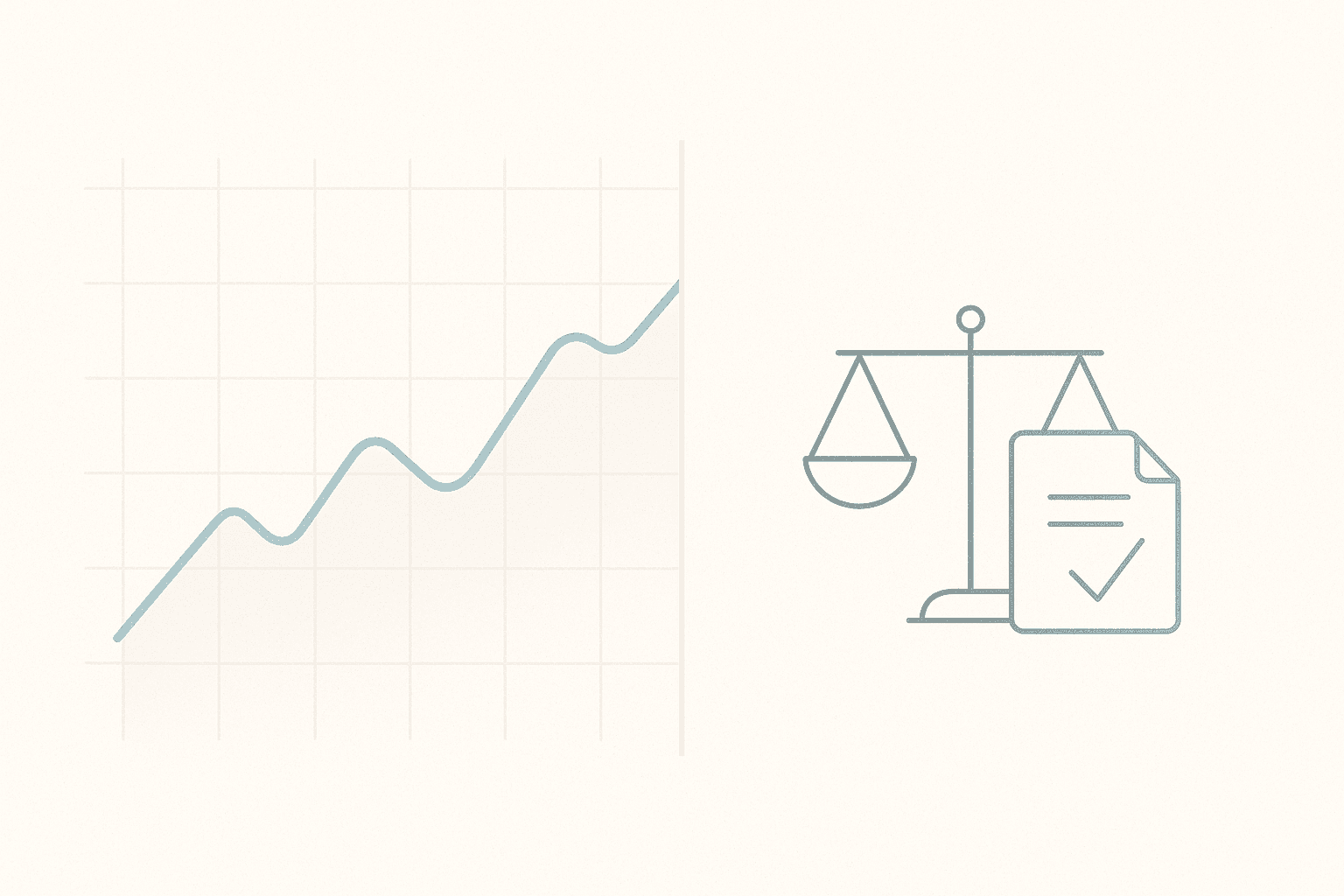AI Lawyer Blog
Cloud Service Agreement Template (Free Download + AI Generator)

Greg Mitchell | Legal consultant at AI Lawyer
3
A Cloud Service Agreement (CSA) is the contract between a cloud provider and a customer that defines services, uptime commitments, data handling, security controls, support, and pricing. It clarifies responsibilities across availability, incident response, data residency, and exit rights so both sides can operate confidently at scale.
According to Eurostat, 45.2% of EU enterprises purchased cloud services in 2023, and most used sophisticated services such as database hosting and development platforms. This widespread reliance makes well-drafted CSAs a business necessity rather than a nice-to-have.
Download the free Cloud Service Agreement Template or customize one with our AI Generator, then have a local attorney review before you sign.
You Might Also Like:
1. What Is a Cloud Service Agreement?
A Cloud Service Agreement is the binding framework that governs use of infrastructure, platform, or software delivered over the internet. It typically wraps a Master Services Agreement with service-specific schedules (e.g., compute, storage, database), a Service Level Agreement (SLA), a Data Processing Agreement (DPA), and a pricing or usage schedule.
The CSA defines which services you get, how performance is measured, and what happens if commitments aren’t met. It also spells out data rights and responsibilities: where data lives, who can access it, how it’s backed up, and how it’s returned or deleted at the end of the relationship. A clear CSA reduces operational risk, shortens procurement cycles, and makes audits easier.
2. Why Cloud Service Agreements Matter in 2025?
Cloud demand and dependency keep rising, and so do the stakes for downtime and data mishandling. Industry research shows that many recent significant IT outages cost over $100,000, with a meaningful share exceeding $1 million, evidence that resilience terms in your CSA are not theoretical.
Meanwhile, independent market trackers report that enterprise spending on cloud infrastructure services hit the hundreds of billions of dollars in 2024, propelled by AI workloads. In short, today’s CSA is business-critical insurance for performance, security, and exit flexibility, not just a procurement formality.
3. Key Clauses and Components
Scope of Services: Define covered services, deployment model (IaaS, PaaS, SaaS), supported regions, and service boundaries.
Service Levels: Specify uptime targets, performance metrics, maintenance windows, and service credit formulas for misses.
Support and Incident Response: Set ticket priorities, response and resolution targets, escalation paths, and status-update cadence.
Security and Compliance: State baseline controls, encryption at rest/in transit, key management, vulnerability management, and audit rights.
Data Governance: Describe data residency options, backups, retention, restoration testing, and customer admin responsibilities.
Privacy and Processing: Attach a DPA covering purposes, legal bases, subprocessors, international transfers, breach notification, and data-subject requests.
Acceptable Use and Customer Obligations: Prohibit abusive activity and clarify customer duties (credentials, configuration, patching where shared).
Fees and Billing: Explain pricing model, metering, invoice timing, taxes, true-ups, and dispute process.
Term, Suspension, and Termination: Define suspension triggers, cure periods, and termination for convenience or cause.
Exit, Portability, and Transition: Provide data-export formats, deprovisioning timelines, deletion certificates, and paid transition support.
4. Legal and Regulatory Requirements by Region
United States: Privacy and security are driven by sectoral laws (HIPAA, GLBA) and state privacy laws; breach-notification and incident cooperation duties belong in the CSA and DPA. Export controls (EAR/ITAR) and sanctions can constrain data location and access.
European Union: GDPR requires a compliant DPA, lawful transfer mechanisms, and transparency about subprocessors and processing purposes. Sector rules (eIDAS, NIS2, DORA for financial services) layer additional obligations.
United Kingdom: UK GDPR and the ICO’s guidance govern processing and international transfers; NCSC principles influence security expectations.
Canada: PIPEDA and provincial regimes regulate personal data; localization rules may apply in public sector or health contexts.
Global Considerations: Data residency, government access requests, and encryption key control should be addressed explicitly for cross-border operations.
5. How to Customize Your Cloud Service Agreement?
Map to your architecture: Align CSA scope to the exact services and regions you will use so SLAs and data locations are accurate.
Tailor resilience: Set multi-AZ or multi-region expectations, backup frequency, RPO/RTO targets, and disaster-recovery tests.
Right-size security: Choose baseline controls and certifications that match your risk profile and audit requirements.
Tune billing levers: Negotiate committed-use discounts, caps on price changes, and visibility into metering to prevent surprises.
Add exit clarity: Pre-agree export formats, bandwidth for bulk transfers, and fees for extended read-only access during offboarding.
Industry overlays: If you’re in finance, healthcare, or critical infrastructure, incorporate regulator-specific wording and audit accommodations.
6. Step-by-Step Guide to Negotiation and Signing
Step 1-Define requirements: Document uptime, support, data residency, security, and exit needs before redlines start.
Step 2-Request artifacts: Ask for standard SLA, DPA, security whitepapers, pen-test summaries, and compliance reports.
Step 3-Align roles and shared responsibility: Clarify where the provider ends and your team begins for security, backups, and incident response.
Step 4-Redline metrics and remedies: Lock in availability math, maintenance exclusions, observability, and service credits.
Step 5-Address privacy and transfers: Ensure GDPR/UK GDPR clauses, SCCs or IDTA, subprocessor notice periods, and breach timelines are included.
Step 6-Tune pricing and commitments: Negotiate spend commitments, discount schedules, EDPs, and usage ceilings or alerts.
Step 7-Define change control: Require notice periods for service deprecations, API changes, and pricing updates.
Step 8-Plan portability: Agree export formats, timeframes, and deletion verification; add assistance rates for migration if needed.
Step 9-Finalize governance: Establish quarterly business reviews, security liaison contacts, and incident post-mortem sharing.
Step 10-Execute and onboard: Sign, capture metadata in a contract register, and run a day-1 configuration checklist.
7. Tips for Security, Reliability, and Cost Control
Design for failure: Use multi-AZ patterns, health checks, and autoscaling; document RPO/RTO in the CSA annex.
Measure what matters: Monitor the provider’s SLA metrics with your own telemetry so credit claims are evidence-backed.
Harden identities: Require MFA, least-privilege roles, key rotation, and customer-managed keys where feasible.
Budget guardrails: Use budgets, alerts, and anomaly detection; require advance notice for price changes and a cure path for billing errors.
Vendor lock-in mitigation: Prefer open formats, portable architectures, and export APIs; negotiate transition help at pre-set rates.
Audit readiness: Keep copies of SOC 2/ISO certificates, DPA, subprocessor lists, and breach-notification playbooks for regulators and customers.
8. Checklist Before You Finalize
Services, regions, and environments listed exactly as used.
SLA targets, measurement windows, exclusions, and credits clearly defined.
Support tiers, response times, and escalation contacts documented.
Security controls, encryption, and audit rights matched to compliance needs.
DPA includes lawful bases, transfer tools, and subprocessor change-notice periods.
Billing model, discounts, and dispute timelines captured with usage-visibility tools.
Termination triggers, cure periods, and suspension rules stated.
Data-export formats, timeframes, and deletion certification agreed.
Download the Full Checklist Here
9. Common Mistakes to Avoid
Vague uptime commitments: Without precise math and exclusions, credits are hard to claim.
Assuming “shared responsibility” covers you: Your team still owns configuration, IAM, and data life-cycle choices.
No portability plan: If you can’t export data fast, exit costs soar.
Ignoring subprocessor changes: Without notice periods, your data may move to vendors you didn’t vet.
Under-specifying incident timelines: Ambiguous response or notification windows cause audit pain.
Forgetting price-protection: Sudden list-price changes can wipe out your savings.
10. FAQs
Q: What’s the difference between the MSA, SLA, and DPA in a cloud deal?
A: The MSA sets overall legal terms like liability, indemnities, and termination. The SLA defines performance targets and remedies such as service credits. The DPA covers personal data processing: roles, lawful basis, subprocessor rules, transfer mechanisms, and breach notifications. Together, they form the core of the Cloud Service Agreement and should be consistent and cross-referenced.
Q: How should we define availability so credits actually apply?
A: Use a monthly percentage with clear formulas, specify what counts as downtime, and list exclusions tightly. Require transparent status pages or APIs to verify incidents. Tie credit tiers to impact levels and allow carry-forward of unused credits in multi-year agreements so remedies have real value rather than expiring each month.
Q: What security assurances are reasonable to expect from providers?
A: Baselines include encryption at rest and in transit, vulnerability and patch management, incident response, and independent audits like SOC 2 or ISO 27001. For sensitive workloads, add customer-managed keys, HSM support, and data-location controls. Ensure audit reports and subprocessor lists are refreshed on a regular cadence with notice of changes.
Q: How do we manage cross-border data transfers under GDPR or UK GDPR?
A: Your DPA should state transfer tools (e.g., Standard Contractual Clauses or UK IDTA), identify subprocessors and locations, and outline supplementary measures like encryption and access controls. Build a change-notice window so you can object to new subprocessors or regions before data moves, and document risk assessments for compliance files.
Q: What should an exit plan include?
A: Define export formats, bandwidth allowances, and timelines for read-only access after termination. Require deletion certificates within a set period and address lingering backups. If you’ll need help, pre-price migration and deprovisioning support to avoid emergency rates. A concrete exit plan prevents last-minute lock-in and business disruption.
Sources and References
Cloud adoption statistics in this article are based on the Eurostat Cloud Computing Statistics – Enterprises 2023, showing that 45.2% of EU enterprises purchased cloud services, with most using advanced functions like database hosting and development platforms.
Operational outage data and cost benchmarks reference the Uptime Institute 2024 Outage Analysis Report highlighting the financial impact of major IT disruptions.
Privacy and data transfer requirements align with the EU General Data Protection Regulation (GDPR), UK GDPR and ICO Guidance, and U.S. National Institute of Standards and Technology (NIST) SP 800-53 and 800-171 frameworks for cloud security and control baselines.
Disclaimer
This article is for informational purposes only and does not constitute legal advice. Laws and standards change by jurisdiction and industry. Always consult qualified counsel and security/compliance professionals before drafting, signing, or relying on a Cloud Service Agreement.
Get Started Today!
A well-structured Cloud Service Agreement aligns performance, security, and budget with your business goals — while preserving your exit options. Use the template, tailor it to your architecture, and lock in verifiable metrics and remedies.
Download the free Cloud Service Agreement Template or customize one with our AI Generator — then have a local attorney review before you sign.
You Might Also Like:



